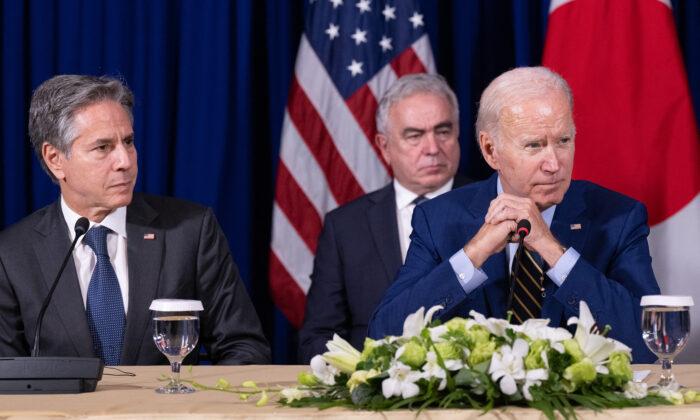Commentary
President Joe Biden met with Chinese leader Xi Jinping and Asian leaders at the ASEAN summit but failed to confront Xi on Burma (commonly known as Myanmar), where a Chinese-funded war against religious and ethnic minorities is occurring.
The war in Burma was one of the primary issues discussed at the Association of Southeast Asian Nations (ASEAN) summit, held on Nov. 10-13. It was the first stop on Biden’s Asian tour.
Although the United States and the European Union have condemned the war in Burma and brought sanctions against the leaders, China and Russia continue to trade with Burma and provide it with weapons. Sadly, Biden failed to confront Xi about China’s role in the war. Burma was also a primary agenda item at the APEC summit, which Biden skipped, providing Xi with an unopposed PR opportunity.
The war against ethnic and religious minorities in Burma has been ongoing since 1948 when the Karen National Union—one of the largest ethnic groups and one of the first independence armies—demanded the rights promised to them at the time of Burma’s independence from Britain. Since then, fighting has continued in varying intensities and among different ethnic and religious factions as they suffered under repression from successive military regimes. Over the years, communists, Buddhists, Christians, Protestants, and Muslims have taken up arms against the state army known as the Tatmadaw.
Burma’s 134 ethnic minorities have all been subjected to repression. Many have formed resistance armies and taken to the battlefield, including the Karenni Army (1949), Pa-O National Army (1949), Mon National Army (1958), Kachin Independence army (1961), the Arakan Liberation Army (1968), Wa National Army (1969), Shan State Army-North (1971), National Socialist Council of Nagaland (1980), Rohingya Solidarity Organization (1982), All Burma Students’ Democratic Front (1988), China National Army (1988), and others.
In 2021, a military coup overthrew the democratically elected government of Aung San Suu Kyi, which resulted in the death of at least 2,400 civilians and the displacement of over 1 million. Many have been internally displaced, while tens of thousands have fled the country.
In 2021, there were widespread reports of military air strikes, shelling, and arson attacks against civilians in the ethnic areas of Kayah State, Kayin State, Kachin State, and Chin State. Civilians are regularly raped, tortured, and used as human shields. In a town called Thantlang, the army burned down at least 160 houses and four churches. In southern Shan State, the military launched an offensive attack killing 55 civilians, and several churches were destroyed. In Kayah State, 35 civilians were killed, including four children and two humanitarian workers from Save the Children. In Kayah State, Catholic churches were targeted, and a Catholic aid worker was shot dead.

Activists, including Burmese nationals, participate in a rally to protest against Burma's junta execution of four prisoners, including a former lawmaker from Aung San Suu Kyi's party, outside the United Nations University in Tokyo on July 26, 2022. Philip Fong/AFP via Getty Images
This year has been no better. In October, during the single most bloody day of fighting, at least 80 people, mostly civilians belonging to the Kachin ethnic group, were killed in an airstrike. On Nov. 3, a Baptist seminary in Kachin State was attacked by the army, and four seminarians were injured. The next day, 80 Rohingya Muslims hoping to escape what Secretary of State Antony Blinken has identified as genocide were detained as they attempted to board a boat for Malaysia.
The United States and the EU have brought sanctions against Burma. However, China continues to fund the regime by buying exports such as liquified natural gas (LNG). The CCP is moving ahead with investments in LNG, seaports, and energy production. Russia uses the conflict to bypass sanctions from the Ukraine invasion by selling gas and oil to Burma. Both China and Russia are selling weapons to the regime. The Tatmadaw is now using Russian- and Chinese-made aircraft to kill civilians.
Apart from the obvious human rights issues involved in China supporting the Burmese generals, the United States and India have a real strategic interest in curbing the CCP’s engagement with Burma. Much of China’s investment in Burma is under a portion of the Belt and Road Initiative (BRI), known as the Myanmar Economic Corridor (CMEC). The terminus of the corridor is a seaport that will allow China access to the Indian Ocean.
On Oct. 21, retired Adm. Gary Roughead, who is also a former U.S. chief of naval operations, said that the Quad security grouping—which includes the United States, Japan, Australia, and India—should maintain a standing maritime force in the Indian Ocean. A Chinese spy ship was sighted in India’s exclusive ocean zone on Nov. 10 as the Indian navy was preparing a ballistic missile test. By investing heavily in Sri Lanka, China already has a potential base of operations in the region. Burma gives the Chinese regime one more point of access, which presents an increased security threat to the region.
Views expressed in this article are opinions of the author and do not necessarily reflect the views of The Epoch Times.





